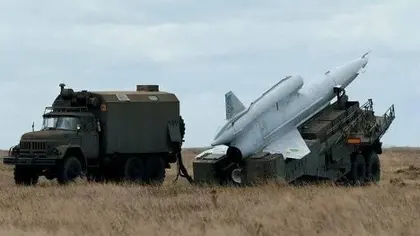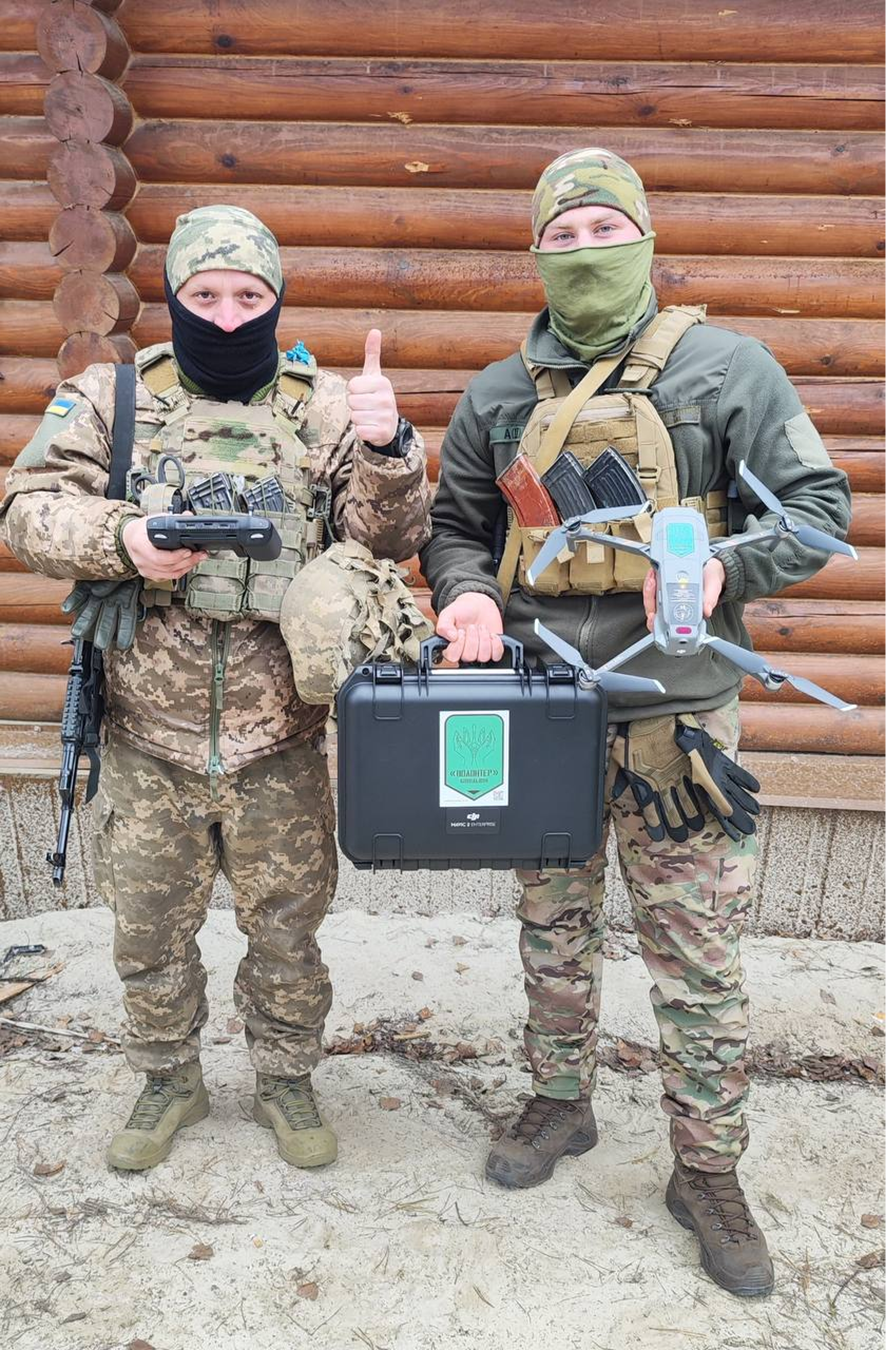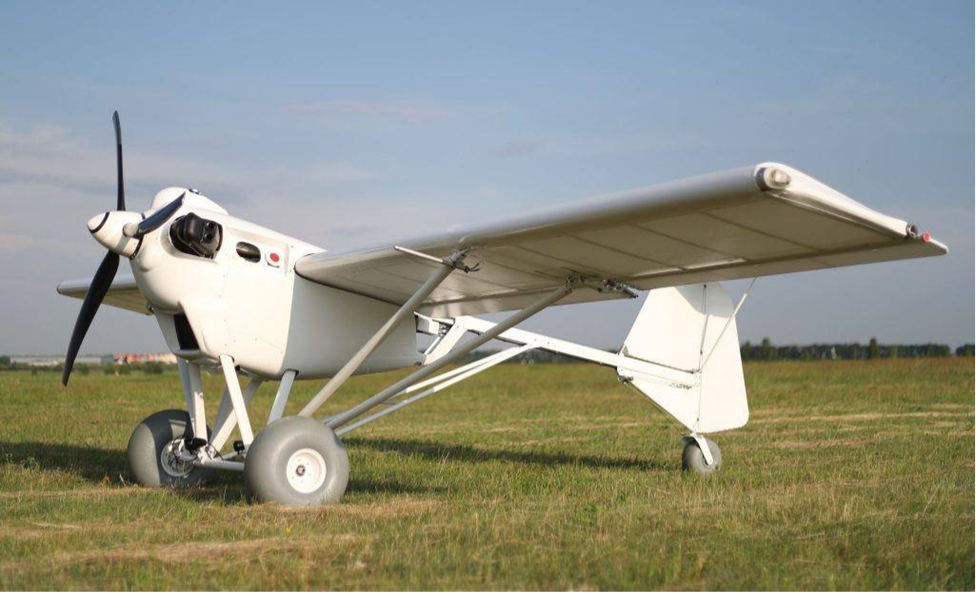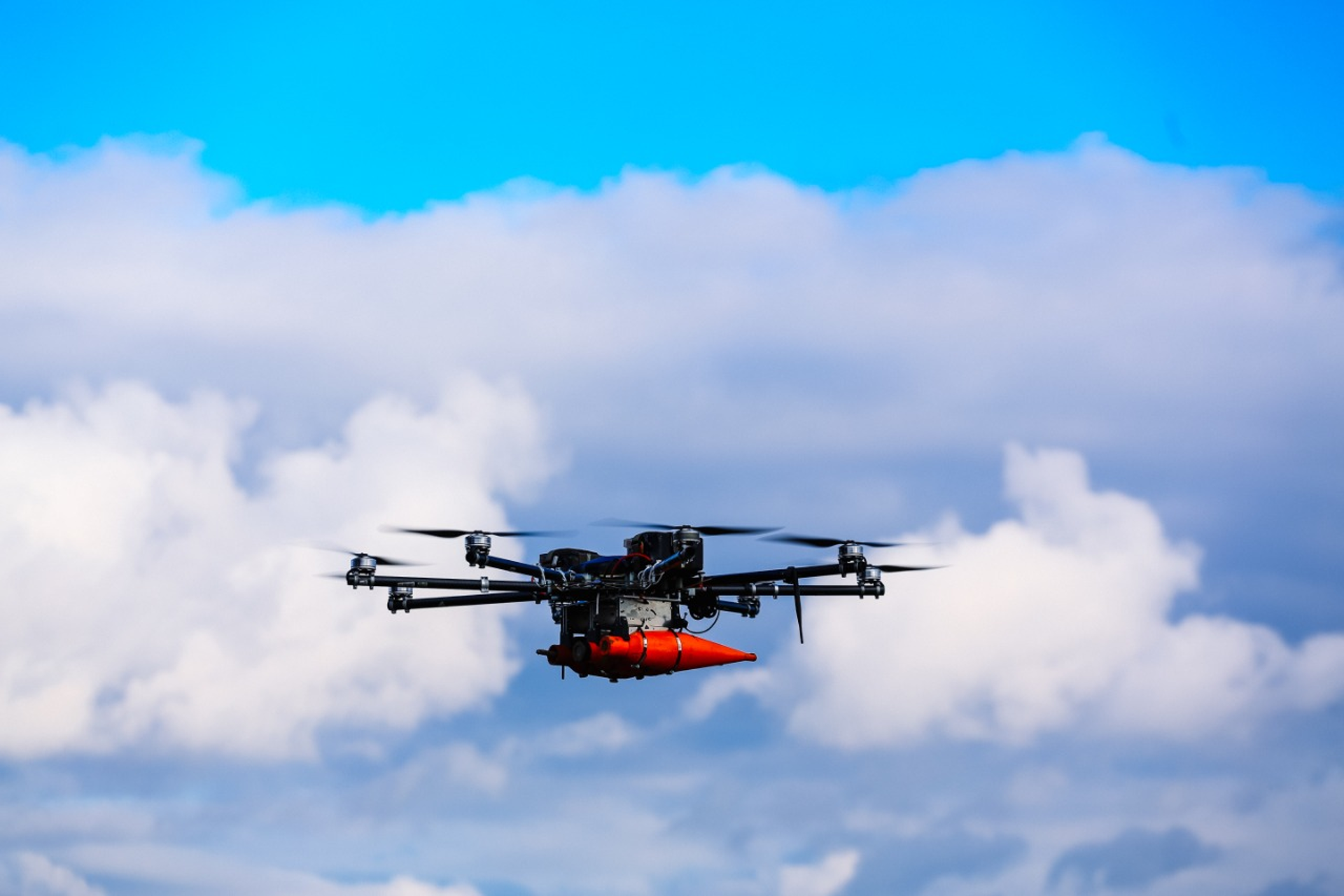It was the most spectacular Ukrainian drone attack of the war - so far.
At a pair of air bases deep inside Russia, on Dec. 5, ground crews were loading cruise missiles and fueling T-160 Blackfire strategic bombers, Tu-95 Bear long-range reconnaissance turboprops, and Tu-22 Backfire swing-wing strike aircraft for renewed air attacks against Ukraine’s power grid.
The day-to-day mission for the 20 to 24 nuclear-capable bombers squatting on the airfields’ tarmacs was deterrence and maritime force projection. But starting in October the Kremlin came up with a new mission for Russian strategic bombers: Firing ground-skimming missiles from the safety of Russian air space at Ukrainian power stations, electricity substations and hydroelectric plants.
In the previous round of Russian attacks, on Nov. 23, a strike package of Bears and Backfires unleashed more than 90 cruise missiles at Ukraine’s power grid, blasting substations and generation facilities, and plunging tens of millions of Ukrainian homes and businesses into blackout for two to four days.
The Dec. 5 follow-up strike was to have been even more devastating – but before that could happen, Ukrainian kamikaze drones flew hundreds of kilometers past some of the Kremlin’s most dense air defenses to blast the airfields literally as Russian bombers were being loaded up with missiles.
In the early hours of the morning, according to multiple reports, at least two Ukrainian drones slammed into Dyagilevo military air base, more than 500 kilometers (311 miles) from the nearest Ukrainian combat units, deep inside Russia’s Ryazan Oblast. Explosions shredded at least one Tu-22M3 bomber, torched a fuel truck, and, according to official Russian government statements, killed three service personnel and injured five. Among the dead was Tu-22 bomber pilot Major Aleksandr Shnotin. Subsequent satellite images of the airfield showed evidence that as many as five aircraft were damaged and unflyable.

Kyiv Hit by Massive Drone Attack as Russian Strikes Target Multiple Ukrainian Cities
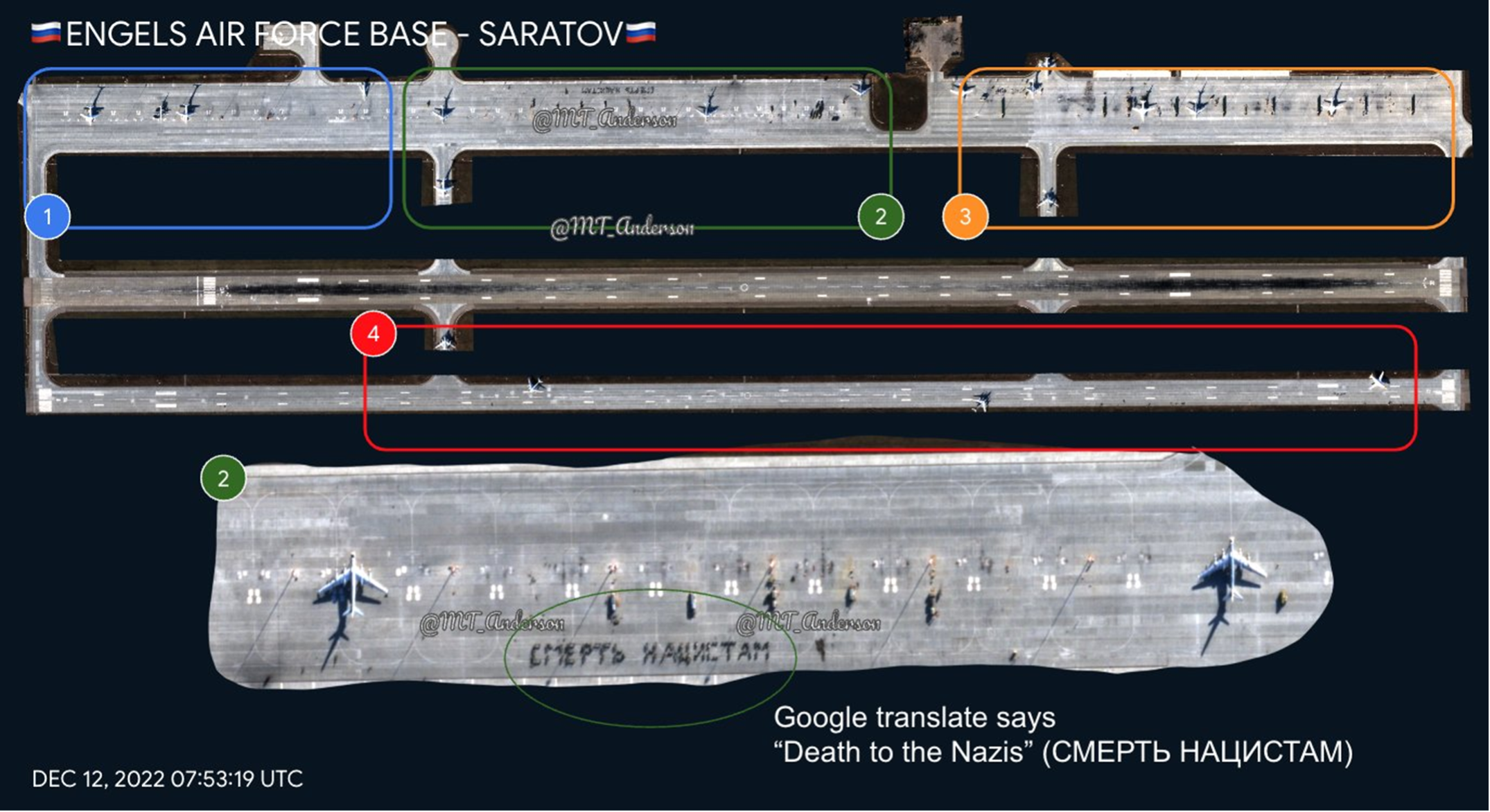
This is a satellite image of Russia’s Engels Air Force base following Ukraine’s Dec. 5 long-range drone strike. The military blogger @MT_Anderson has circled locations where a total of more than 20 Russian strategic bombers were present prior to the strike, and which subsequently left. The green circle identifies a message in 20-meter letters apparently created by Russian ground personnel for satellite overflight viewers. The message (in Russian) reads: “Death to Fascists”.
At Engels Air Force Base, a good 650 kilometers (404 miles) away from the closest armed Ukrainians and not far from the central Russian city of Saratov, a single explosion damaged at least one, and possibly more, Tu-95MS bombers, all probably belonging to the 184th Heavy Bomber Aviation Regiment.
Kremlin spokesman Dmitriy Peskov said Ukrainian drones with a new, long-range capacity had carried out the attacks and vowed Russia would retaliate. Britain’s defense ministry called the strikes destroying or damaging as many as eight of Moscow’s most capable and expensive bombers “some of the most strategically significant failures of force protection since its (Russia’s) invasion of Ukraine.” A Dec. 10 analysis by the Global Defense Corp. think tank noted “(Ukrainian drone) strikes on such crucial military installations (destroying Russian strategic bombers) will raise questions.”
According to Ukrainian news agencies, Ukrainian government engineers probably repurposed two to four Cold-War-era Tu-141 reconnaissance drones originally manufactured in Kharkiv to hit the two airfields. Developed in the 1960s for the Red Army and taken out of service in 1989, Ukrainian engineers upgraded the aircraft with modern guidance systems and warheads, a UNIAN news agency report said.
On the front lines, Ukrainian soldiers started flying drones self-financed or purchased by donations in the early days of Russia’s initial invasion of Ukraine back in 2014. At the time it was either figure out a way to deploy cheap, off-the-shelf drones or fight blind.
In 2022, in most Armed Forces of Ukraine (AFU) combat brigades, a visitor can reliably find an air reconnaissance section still operating made-in-China Mavic drones, but now costing sometimes tens of thousands of dollars. Enterprising operators now routinely modify drones to carry grenades and even mortar rounds to drop onto enemy foxholes and in better Ukrainian combat units drone-collected targeting data – the grid coordinate of what the drone’s sensor detects – is fed by direct downlink into the AFU fire control data network.
“There is no way to fight a modern war without drones. We need them for everything,” a battalion drone section commander Viktor Pavlov told Kyiv Post in an interview. “As time goes on, the drones we operate are getting bigger, faster, more powerful, and more complicated…but the key component is the imagination and skill of the operator.”
“The problem is - and I try and explain this to people - that there is no funding and no support and no interest in training (at the small unit level). I try to explain to people that it’s great giving someone a drone, but one, if they’re not trained to use it, or if two, they’re not a capable soldier that’s been trained, how do they get to the place to fly the drone?” explained Daniel Ridley, director and founder of Trident Defense Initiative.
Pavlov said “hundreds” of tactical drones operated by AFU units probably take to the air daily along the war’s 1,800 kilometer (1,118 mile) line of contact, practically all bought by private funding outside normal defense ministry contracting. Ridley said the AFU must eventually step away from its present drone policy where volunteers and enthusiasts operate cheap drones at the tactical level, while the army central command focuses resources and doctrine only on major aircraft.
The flagship drone operated by the AFU, the Turkish-made Bayraktar TB2, by most accounts altered the course of battle during Ukraine’s defense of the northern cities Kyiv and Zhytomyr. Equipped with powerful night-vision optics and carrying anti-armor guided missiles, and used by the AFU as a flying counterattack platform, Bayraktars in February and March surprised and cut up advancing Russian tank columns. In April, navy operators used a Bayraktar drone to distract defenses aboard the Russian Black Sea fleet’s flagship, the cruiser Moskva, allowing a pair of Ukrainian cruise missiles to sink it.
Bayraktar losses have mounted as Russia has improved its air defenses and, of the 50-plus aircraft Ukraine has received since the war started, at least 40 have been shot down, the military intelligence group Janes reported.
Some foreign drones have fallen somewhat short. In May Ukrainian special forces began operating American-made Switchblade-300 kamikaze drones, a weapon designed to hunt insurgents and limit collateral damage in Afghanistan. The Ukrainians found Switchblade to be very portable, easy to use, and equipped with excellent optics, but lacking a warhead capable of seriously damaging a Russian armored vehicle.
Home-grown production moved in to fill some of the gaps. The Ukrainian agricultural services company AeroDrone, which before the war sold aircraft to survey fields and deliver packages, announced on Dec. 8 the Ukrainian government had certified two of its aircraft, the E-300 Enterprise (payload up to 300 kilograms or 660 pounds) and D-80 Discovery (payload up to 80 kilograms or 176 pounds) for military use.
On Dec. 10, Oleh Boldyrev, head of the Ukrainian national arms manufacturer Ukroboronprom, told the Nastoyashcheye Vremya television program the government was in the final stages of testing a locally developed drone that will be able to carry 75 kilograms (165 pounds) of explosives 1,000 kilometers (621 miles) – about as far as Moscow is from Kyiv.
Ukraine has repeatedly petitioned the U.S. for deliveries of its top-of-the-line Gray Eagle strike drone. The last time that Pentagon spokesmen said the system is too complicated and sensitive technically to transfer to Kyiv was in late November.
Ukrinform report about AeroDrone.
You can also highlight the text and press Ctrl + Enter


